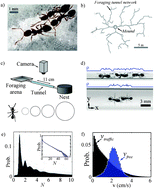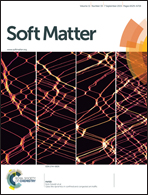Glass-like dynamics in confined and congested ant traffic†
Abstract
The collective movement of animal groups often occurs in confined spaces. As animal groups are challenged to move at high density, their mobility dynamics may resemble the flow of densely packed non-living soft materials such as colloids, grains, or polymers. However, unlike inert soft-materials, self-propelled collective living systems often display social interactions whose influence on collective mobility are only now being explored. In this paper, we study the mobility of bi-directional traffic flow in a social insect (the fire ant Solenopsis invicta) as we vary the diameter of confining foraging tunnels. In all tunnel diameters, we observe the emergence of spatially heterogeneous regions of fast and slow traffic that are induced through two phenomena: physical obstruction, arising from the inability of individual ants to interpenetrate, and time-delay resulting from social interaction in which ants stop to briefly antennate. Density correlation functions reveal that the relaxation dynamics of high density traffic fluctuations scale linearly with fluctuation size and are sensitive to tunnel diameter. We separate the roles of physical obstruction and social interactions in traffic flow using cellular automata based simulation. Social interaction between ants is modeled as a dwell time (Tint) over which interacting ants remain stationary in the tunnel. Investigation over a range of densities and Tint reveals that the slowing dynamics of collective motion in social living systems are consistent with dynamics near a fragile glass transition in inert soft-matter systems. In particular, flow is relatively insensitive to density until a critical density is reached. As social interaction affinity is increased (increasing Tint) traffic dynamics change and resemble a strong glass transition. Thus, social interactions play an important role in the mobility of collective living systems at high density. Our experiments and model demonstrate that the concepts of soft-matter physics aid understanding of the mobility of collective living systems, and motivate further inquiry into the dynamics of densely confined social living systems.


 Please wait while we load your content...
Please wait while we load your content...